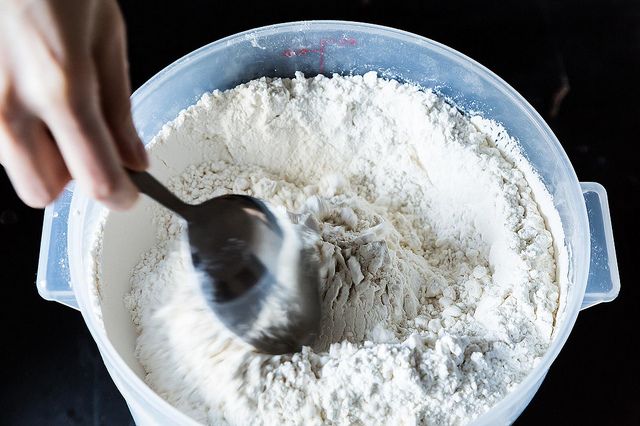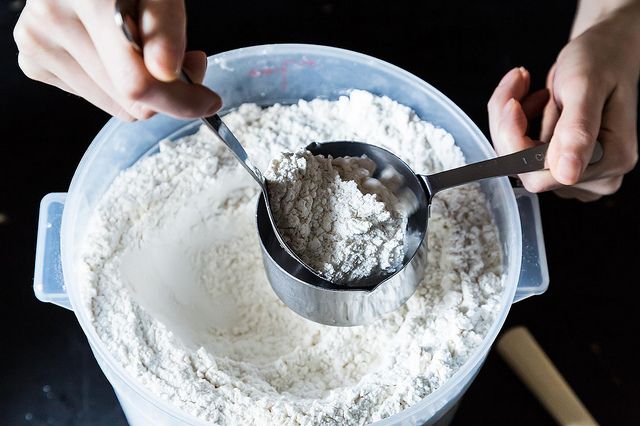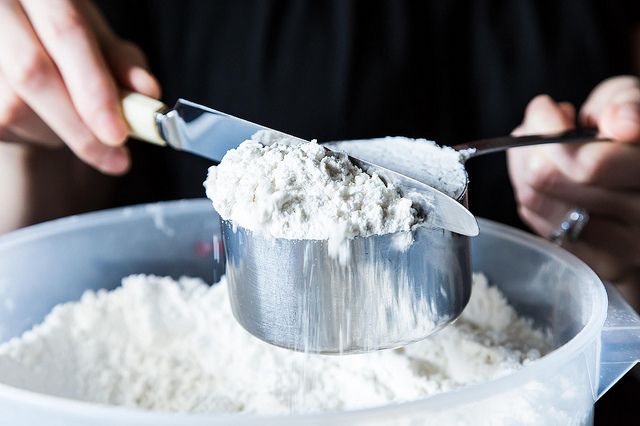Popular on Food52
26 Comments
Janet W.
August 24, 2014
Where can you get a good collection of recipes written in ounces? Most recipes I find online or in cookbooks in the u.s. Are all written in cups and table spoons. To start using those recipes should I convert them to weight? I have seen several recipes in metric from international sources, but not a lot in ounces.
AntoniaJames
August 25, 2014
I'm interested in the answer to this question, too. I plan to start a new Collection here on Food52 just for recipes stated in metric measures. Whenever possible, I convert to weight; the easiest, and most reliable, source of information if you are in the U.S. and using ingredients that came in a package (vs. via a bulk bin), is to use the conversion rates on the nutrition label. It's still imperfect, however, because there can be vast discrepancies between what the company's conversion and actual practice. A case in point: in certain "top" recipes here on the site, there are recipes with quantities of flout stated both in grams and in cups. Their conversions, however, are in the range of 140 - 144 grams per cup, while King Arthur Flour and all the other flour packages I've seen state the ratio as 120 grams per cup. Obviously, a different method of measuring was used by the Food52 columnists.
I must mention here as well that using a scale for measuring peanut butter and similarly messy ingredients directly into a mixing bowl makes clean up so much easier! ;o)
I must mention here as well that using a scale for measuring peanut butter and similarly messy ingredients directly into a mixing bowl makes clean up so much easier! ;o)
Pamela_in_Tokyo
June 26, 2014
What is it with us Americans?? Why can't we go digital? Weigh the flour!!! I live in Japan and I've been weighing my ingredients including flour for 45 years now. It is so easy. I have such a hard time with American recipes with that old dip and sweep method. Japanese flour bags are not made for the dip & sweep method, I'm always adding too much flour when I use the American method. Using a scale is so much easier for all ingredients! I think America must be the only country in the world that has not gone digital!
kevlette
January 10, 2014
While I agree that if you aerate, spoon and sweep you will usually get 4.5 ounces of flour per cup, some books/chefs want 5 ounces of flour per cup - which you get by dipping and sweeping. Also, Martha Stewart's Baking Handbook reccomends the dip and sweep method (not spoon and sweep as cited above) so it really just depends on the technique used by the author. Of course, the only way to know for sure is to weigh your flour!
tigerlille
September 18, 2013
This is the way I measure my flour, and it works perfectly. I aerate before measuring whether or not the recipe calls for the flour to then be sifted.
mattmill
September 18, 2013
You mention 4.5oz/cup but KAF says 4.25oz/cup in the link of your article. I use this chart from their site for my measurments http://bit.ly/17JVcT0 Always has worked out for me.
loubaby
April 10, 2013
It really does make a difference....however if you are making a recipe from Giada De Laurenti or other TV chefs, Giada does the dip cup in flour method...so be sure you know how the cook whose recipe it is does it...
Linn
January 17, 2013
My vote goes to the scale and the metric system. For cooking though, in all honesty, not sure it makes a difference. I have never done much baking and my recipes have always been written in both grams and volume equivalents. It’s so easy to do both because when you cook the proportions are so forgiving. But I took up baking recently and discovered things are different when you bake. A couple extra tablespoons can make a difference and rounding can get you into trouble. Since I prefer recipes with nice round numbers, I no longer try to estimate volume equivalents for my recipes. It is too confusing. Who has patience for 5/6 cup KAF white whole wheat flour when 100 grams will do?
millicent
January 16, 2013
im from australia and we use metric, how many grams is 4.5ounces ?
Kurt O.
September 18, 2013
That should be ounces to grams, not grams to ounces. :p http://goo.gl/wpBVBo
1 ounce is roughly 28.3g for dry, and roughly 29.6mL with liquid (assuming density being nearnthat of water).
1 ounce is roughly 28.3g for dry, and roughly 29.6mL with liquid (assuming density being nearnthat of water).
EmilyC
January 16, 2013
I love to bake, and I have a scale. Do I always use it? No. Sometimes I just want to get out my measuring cups and measure flour the way my mom taught me, which is exactly the method you describe above. Sometimes using the scale feels a little too precise for something as homey as say chocolate chip cookies for my family. There's a place for both methods, and I personally like to see recipes that offer both volumes and weights so the cook can decide.
AntoniaJames
January 16, 2013
P.S. The time you save by weighing instead of measuring exceeds by far the amount of time it takes to take a kitchen scale out of a cupboard. I have a flat OXO scale which slides easily in on its side in next to one of two appliance base "garages" (small cubicles) that flank my microwave in a cabinet over my counter. Since I started using a scale whenever possible, I just have not understand why anyone would ever prefer to measure with cups and spoons -- especially ingredients like peanut butter and sour cream. ;o) P.S. Brette, you should do a "Kitchen Confidence" column on using a kitchen scale. I'm sure I'm not the only one here with a variety of helpful tricks on that topic.
AntoniaJames
January 16, 2013
Also, for people who regularly measure with cups and not a scale, this may be helpful: Chopsticks are my favorite tool for leveling off dry ingredients. I keep a clean (never used) one in each of my large flour canisters for this purpose. The really cheap ones from your local carryout can be snipped with kitchen shears to size. No more reaching for and then having later to wash a knife. I also keep one in the drawer with my measuring spoons for leveling off baking powder and soda. ;o)
AntoniaJames
January 16, 2013
I'm with MelissaH 100% on using a scale whenever possible. If a recipe doesn't include the quantity in weight, I either look at the side of the package (if not bought in bulk) and do a quick mental conversion, as all U.S. dry ingredients, and things like peanut butter, provide both grams and cups/tablespoons, etc. E.g., if the recipe says to use 1 cup and the nutrition data says that 1/4 cup = 32 grams, I simply multiple that 32 by 4 and weigh the ingredient instead. (This is particularly handy for messy ingredients like peanut butter.) For bulk items, I go to a source such as this http://www.traditionaloven.com/conversions_of_measures/flour_volume_weight.html , but see this for an interesting discussion on the variation within King Arthur Flour reported by different subject matter experts: http://www.thefreshloaf.com/node/14511/measuring-flour-weight . Here's a handy resource for converting dry ingredients other than flour, and liquids: http://www.jsward.com/cooking/conversion.shtml .
Finally, I regularly take notes within my own recipes, measuring with a cup and then weighing ingredients such as pumpernickel flour, barley flour, wheat germ, etc., that I only buy in bulk, to get the metric data I need going forward. (And I have it on my next-action-time-permitting lists to update my recipes here.) ;o)
Finally, I regularly take notes within my own recipes, measuring with a cup and then weighing ingredients such as pumpernickel flour, barley flour, wheat germ, etc., that I only buy in bulk, to get the metric data I need going forward. (And I have it on my next-action-time-permitting lists to update my recipes here.) ;o)
MelissaH
January 16, 2013
Or...you measure the flour the simple way, and (drumroll, please) get a scale. Easily reproducible, and easy to make multiples of the recipe (especially if you use the metric system). If everyone used the scale, think of all the columns like this one that wouldn't have to be written, thereby making more room for good recipes!
Jamie@lifesafeast
January 16, 2013
I have found that different cooks and different cookbooks have different ways of measuring flour and one can get into trouble if one makes an assumption and measures flour differently than the author of a cookbook when baking from one of their recipes. A good baking book explains the method of measurement or, even better, gives the weight.
Vitor H.
January 16, 2013
As much I like Food52, the best advice for measure properly flour (or anything) is: get a scale. 100g flour will be 100g flour in everywhere.
For me (I live in Brazil): cups range 200-250mL, volume changes…
For me (I live in Brazil): cups range 200-250mL, volume changes…
ryanm
January 16, 2013
I think the issue is that many recipes (including Cook's Illustrated, I believe) are *not* designed for the spoon method but rather the scoop one. So while the scoop method adds too much flour for recipes with the spoon method in mind, the opposite can also be the case. Until everyone commits to measuring by weight there will be no failsafe method to calibrate bakers to recipes.
vvvanessa
January 16, 2013
Though I almost always use a kitchen scale to measure flour, I still love whisking the flour and spooning it in to a cup and leveling it off, and then when I turn the cup over and dump the flour out into a bowl, it makes a great "fwhoomp" sound. I love it.
Years ago, when I started using the King Arthur Flour Cookie Companion, I learned quickly to rely on their weight measurements based on how consistently good their recipes are. They weigh flour at 4.25 ounces per cup, and that's the measurement I have committed to memory, though sometimes I might add a touch more if I'm not using one of their recipes.
Years ago, when I started using the King Arthur Flour Cookie Companion, I learned quickly to rely on their weight measurements based on how consistently good their recipes are. They weigh flour at 4.25 ounces per cup, and that's the measurement I have committed to memory, though sometimes I might add a touch more if I'm not using one of their recipes.





See what other Food52 readers are saying.